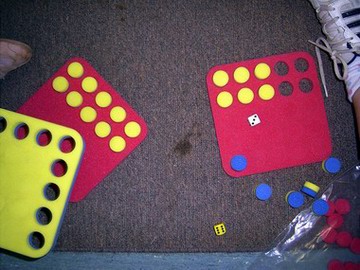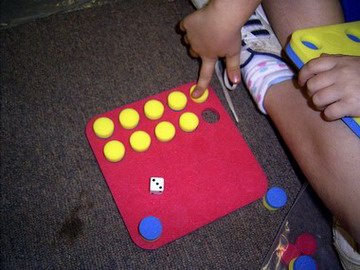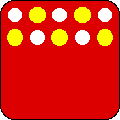| Player A now rolls again and adds more yellow plugs to their board. If their total is now ten or more, 10 plugs are exchanged for a blue which is placed on the other side of the board. For some children it might be necessary as a transitional step to fill the board and complete adding yellow plugs outside the board before the exchange is made.
When the exchange has been completed (if it is necessary on this turn), Player A uses their calculator again to continue the running record of the current move.
Explanation:
When the game began Player A had no plugs in the board, so their calculator showed zero. Then Player A rolled a 5, plugged in 5 yellow plugs and added 5 to their calculator. So, if 6 was rolled on the second turn, Player A would now press [+] [6] [=] and the screen would show 11, which matches the value of plugs on the board, ie: one blue worth 10 plus one yellow worth 1.
- Note: Using the calculator provides a visual link between the symbolic representation on its screen, the kinaesthetic action of placing the plugs and current number of tens and ones.
Player B now has their second turn and play continues in this manner until the chosen number of tens is reached or exceeded.
| In this Year 1 at Holy Rosary School, Derby, the child on the right has already made 10 once (indicated by the blue plug) and has just rolled three more towards the next ten. |
 |
 |
Now she has plugged in the those three.
Take every opportunity to encourage children to read the number value they are currently up to and verbalise its tens and ones. In this case, she is up to 19, made from 1 ten and 9 ones.
This class is playing to be the first to make 5 tens (5 blue plugs).
|
Tens Only Version
In this version the game is combined with the activity Ten Friends and only one Poly Plug and a 'possy mat' are needed per pair. Children work together to collect ten red plugs on the 'possy mat'. As the game proceeds, the red plugs which were removed to make the 10 frame will be used to record tens on the 'possy mat'.
The children begin by playing Ten Friends and each time the frame is filled in that game they place a red plug on the 'possy mat' to record it. They say to each other: We made ten. They can also keep a running record on the calculator using addition.
Players swap roles and play Ten Friends again. This time when they transfer their red plug to the 'possy mat' they say to each other: We made ten more. Ten and ten make twenty, and touch the red plugs as they say it. So, after two frames, the children would see:
The game continues in this way as far as the children can take it, but, eventually - and very soon for some children - until they can say (and touch):
We made ten more. Ten and ten and ten and ... and ten make one hundred!
|
 |
Matthew Harpley & John Harnett
St. Mary's Primary School, Moruya
Year 6
Our first few sessions of playing Ten Tens was done as a whole class activity. This enables the children to learn the rules and observe others playing the game.
After the initial sessions it became one of the activities used during weekly group work rotations. In general, the class found this activity ... engaging and enjoyable. Remembering to predict the answers and enter the numbers on the calculator proved to be a challenge for some.
Threading
- We played the game in a similar fashion, however we started with a total of 100 and the aim was to subtract until they reached zero.
- We played the game and renamed it Ten Hundreds. We used a ten sided dice that had the numerals 10 - 100.
- We played the game and renamed it Ten Thousands. We used a ten sided dice that had the numerals 100 - 1000.
- We played the game and renamed it Ten Ten-Thousands. We used a ten sided dice that had the numerals 1000 - 10000.
- Finally we decided that we could play a combination of these games depending on how high we wanted to go. Some children combined two Poly Plug boards and played to 1000 or 10000. To do this the children used several of the above mentioned dice. Each player took their turn by rolling a combination of the dice to get a total that included ones, tens, hundreds and even thousands.
- Several groups attempted to play the game using 3 Poly Plug boards each and more dice. This became quite complicated as there were many plugs to change each turn.
Reflection
It was interesting to observe the children using their knowledge and understanding of place value and addition to complete the various activities. The threaded activities (derived from) Ten Tens became a focus point for my 'strugglers' and for my 'higher achievers'.
Since attending the WLAM workshop in Term 1, calculators have been a 'MUST HAVE' tool for all activities. The children have taken to this tool and are much better at using it correctly. At first many took the short cut and used them to get the answer. Now, most use them as a visual representation of their work and as a means of checking solutions.
Other classes are now adopting the use of calculators both as a means of checking work and as a visual representation. Our students are becoming more confident and competent when using calculators.
As far as our own learning we both appreciated having a great concrete material (Poly Plug) that could be used in so many ways. It reinforced how our students learn in different ways and some children require the 'hands on' experiences in order to develop an understanding of certain concepts.
Editor's Notes
- WLAM workshop - a sequence of 6 days professional development (three sets of two days) for several schools organised by Gina Galluzzo and the team at the Canberra Goulburn Catholic Education Office and presented by Mathematics Centre.
- John has also written about the development of a Year 6 / Year 1 Buddy System which developed as an outcome of this PD programme.
|







